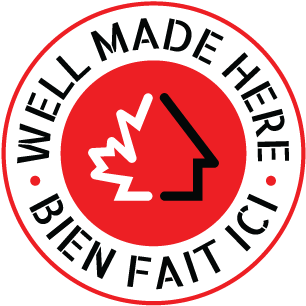“Well Made Here” and Le Panier Bleu
Choosing an accredited “Well Made Here” product adds value to one of the most important investments: the home. It is also a definitive action that supports employment in Canadian manufacturing and retail businesses. Investing with confidence in quality and sustainability out of love for what is made in Canada demonstrates solidarity and the time has come.
 The management of AQMAT, instigator and founding member of the “Well Made Here” program, has communicated multiple times with Pierre Fitzgibbon, Minister for Economy and Innovation of Quebec as well as to the management of the mega site cleverly named “Le Panier Bleu” (The Blue Basket) seeking for the site to truly put the spotlight on products originating from the province. After all, the purpose of their project claims to encourage “local buying”.
The management of AQMAT, instigator and founding member of the “Well Made Here” program, has communicated multiple times with Pierre Fitzgibbon, Minister for Economy and Innovation of Quebec as well as to the management of the mega site cleverly named “Le Panier Bleu” (The Blue Basket) seeking for the site to truly put the spotlight on products originating from the province. After all, the purpose of their project claims to encourage “local buying”.
A wasted effort. At the time of publishing its magazine, not an inch of terrain had been gained by the AQMAT.
Outcomes from this experience surrounding online marketing in support of local buying can inform those that arise in other provinces. Understanding their framework better can help participating manufacturers and partner retail stores determine whether these sites are truly beneficial to their take-to-market strategy.
Le Panier Bleu is trying to take over from La Toile du Québec. As several observers have pointed out, navigation on an Internet portal has evolved so much in two decades that today, consumers are looking for a product or service, sometimes a brand, but much less often do they search for a store by name.
In fact, if one is looking for a BMR, then one types “BMR” in the Google Search bar rather than wasting time entering it in a portal or a larger marketplace like Amazon.
Phase two of the Quebec government’s blue project is being given lip service as it intends to give the search engine the ability to render search results filtered by product. The challenge, therefore, will be to direct those using the site towards products from Quebec. Otherwise, what is the point of recreating an Amazon which does not discriminate as to the origin or the properties of the products it presents.
The new question currently preoccupying site promoters can be summarized as follows: how will products from Quebec be distinguished from others?
It may be an insoluble problem. Each economic sector has its own criteria: the criteria for beef to be considered as from Quebec or elsewhere is likely not the same as it is for items like a chair.
There is no doubt that the future of possible relationships between initiatives like Le Panier Bleu and a program like “Well Made Here”, which focuses on the origin of products and quality standards specific to construction, lies in any such portal’s ability to grant visibility to sectoral accreditations and certifications.
At the AQMAT and undoubtedly among the major partner banners of “Well Made Here” as well as among the hundreds of manufacturers already participating, a tightening of the eligibility criteria would be welcome whereby market intruders would be excluded from Le Panier Bleu. It should be noted that a large percentage of the companies listed on the site are not retail businesses established to serve consumers properly. Many are virtual traders, personal or professional service firms and manufacturers rejected by the large retail chains.
The President and CEO of the AQMAT and Chairman of the Board of Directors of the “Well Made Here” organization, Richard Darveau, comments the project in his editorial on pages 6-7 of the next AQMAT magazine, a French language publication. If a cleanup of Le Panier Bleu is done and a strategic direction replaces the catch-all approach that emerges from the online embryo, forces will be joined in the interest of the citizens, that goes without saying.
Filtered searches for accredited products in the Catalogue
The development of the ici-here.ca online catalogue, which is certainly still in beta, will lead to a web hub for all the accredited “Well Made Here” products made by thousands of manufacturers scattered across the province and the country.
It already lists some 600 lines of product totaling 6000 items made by over 100 manufacturers.
To ensure searches are completed quickly, the site was updated so that the six filters (category, rooms of the house, manufacturers, certifications, province and banners) display the results as the filters are applied according to the choices of the person browsing the catalogue. Other improvements were made to the interface to allow manufacturers to better showcase their accredited products.
Here is a site navigation video for filtered searches.
